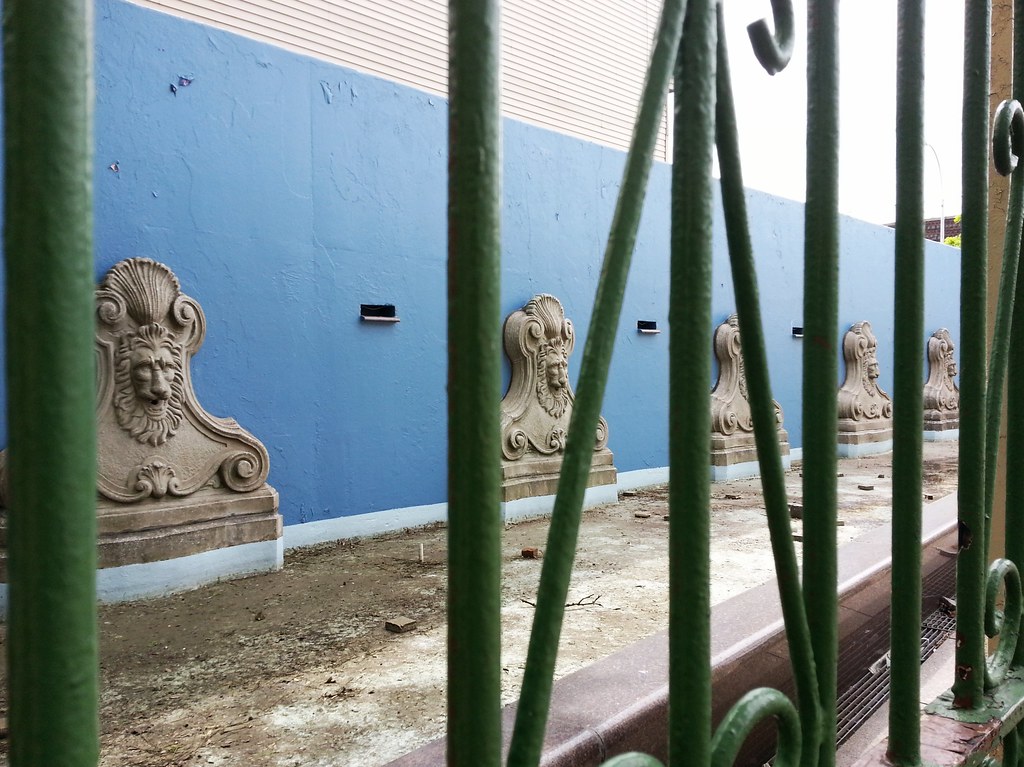
Originally known as Tiffany Plaza when it was dedicated in 1981, this strange little parklet comprises the dried-up leonine fountains you see above, as well as an adjacent wooded plot containing a couple of dozen honey locust trees. (You can take a look around in Street View.) Judging by some old photos, the area was once fully open to the public, but the fountains and most of the trees are now enclosed by fences and locked gates. The photos also show a raised speaker's platform located in front of the fountains. It was apparently intended to be used for "civic and religious events", but was removed sometime during the intervening years.
The man for whom the plaza was renamed, Father Louis Gigante (or Father G., as he is often called), is a priest sprung from a family of mobsters. It's hard to believe Martin Scorsese hasn't made a film about him, although the two are apparently friends. According to the NYPD, three of Father G.'s brothers were Mafiosi, most notably Vincent "The Chin" Gigante, the former boss of the Genovese crime family, who was famously known for his decades of publicly feigning insanity. As the NY Times reported in his 2005 obituary:
For Mr. Gigante, the guise that he adopted in the mid-1960's — behavior that won him the nickname Oddfather — took considerable effort to maintain. He could often be seen shuffling around his Greenwich Village neighborhood in pajamas, bathrobe and slippers, mumbling to himself and appearing to be a disturbed but harmless person. Law-enforcement agents, prosecutors and Mafia defectors described his behavior as a staged performance calculated to evade prosecution for his activities as head of a crime family that under his leadership became the wealthiest and most powerful in the nation.His elaborate ruse was successful in delaying his prosecution for years, and he managed to convince "some of the most respected minds in forensic psychiatry and neuropsychology" that he was mentally incompetent, but he was eventually put on trial anyway, and was convicted of racketeering and murder conspiracy in 1997. Letting his guard down in prison, he was recorded having numerous normal-sounding phone conversations with friends and family. This finally led him to admit in court in 2003, after all those years, that the whole thing had been an act.
But let's get back to Father G. He served for four decades as a priest at St. Athanasius Church (also the longtime home of the "legendary" Sister Thomas), which stands just across the street from the plaza that bears his name, but he is best known for his work outside the church. As the founder of SEBCO, the Southeast Bronx Community Organization, he has been highly lauded for the significant role he played in rebuilding Longwood and Hunts Point, the once-ravaged neighborhoods that surround his church, with SEBCO developing some 5000 units of low- and moderate-income housing in the area.
Despite his heavenly calling and his work in the community, however, Father G. is no stranger to controversy. There's been innuendo and speculation over the years about his possible connections to the Mafia — not surprising, given his family ties — although he's never been formally accused of any wrongdoing. He did, however, spend a week in jail in 1979 when he "refused to answer grand jury questions about his efforts to have Corrections Department officials ease the rigors of prison life for James Napoli, whom the authorities called a gangster." He also helped further his mob boss brother's attempted deception of the authorities, fighting (unsuccessfully) to have Vincent declared mentally unfit to stand trial. (Father G. has insisted that the Mafia is just "a creation of the media", and that Vincent was a "gentle man", a "just man", and a "man of God".)
For years and years, he received universal acclaim for creating "a concrete and brick miracle in a neighborhood that was legendary for the resoluteness of its death march", but some of that luster has now begun to fade. In 2007, the Village Voice ran an article calling him a "slumlord" for allowing living conditions in some of his buildings to deteriorate drastically while he continued to pull in a $150,000 salary from his various community enterprises. Regarding the wealth he has acquired, Father G. makes no apologies. "I didn't take a vow of poverty", he was quoted as saying, with characteristic brashness, in a 1981 NY Times article. "People think I don't get paid and that I'm a saint for doing it. That's their problem." After all, "If I weren't here, it would be all devastation . . . If I want to kiss myself or something, I'll kiss myself."



I knew Lou In school. Would love to hear from him
Fr. Gigante, I hope you can help my friend. Her son Steven Aiello disappeared from the Bronx when he was 22. His name is still on the missing person web-site, We believe it was a Mafia retribution hit. My friend Lucielle has no other family and she is now 69 years old and in poor health. She would like her sons remains found so that she can bury him with his father before she passes. It has been 21 long and painful years for her. Please help her to achieve some peace. If not, please pray for her.
I was a South Bronx kid in St. Jeromes parish and worked many years as a teenager in Summer in the City. Some of my favorite memories doing street clean ups and skits from West Side Story. A happy relief from a violent alcoholic family. Unfortunately the disease has afflicted my son also and he is struggling too. Keep him in your prayers also.
Thanks you for any help you can provide.